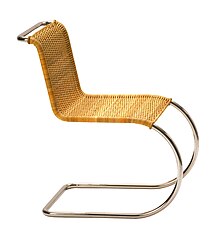Lilly Reich
Lilly Reich (* 16th June 1885 in Berlin , † 14. December 1947 ibid) was a German designer of modernity . From 1926 she worked closely with Ludwig Mies van der Rohe for over ten years , including on the Barcelona Pavilion and the Villa Tugendhat . The German Werkbund accepted her as the first woman on its board. In 1932 she became head of the Bauhaus extension workshop .
Live and act

Reich completed an apprenticeship as a crank embroiderer and then worked under the direction of Josef Hoffmann in the Wiener Werkstätten from 1908 . Three years later she returned to Berlin and worked on the design and creation of furniture and fashion items. She maintained contacts with the design theorist Hermann Muthesius and worked with Else Oppler-Legband .
In 1912 Reich became a member of the German Werkbund and in 1920 joined its board. Before the First World War , their design and furnishing ideas became well known. From 1924 to 1926 Reich worked for the trade fair office in Frankfurt am Main , where he made the acquaintance of the architect Ludwig Mies van der Rohe . In the years that followed, a close relationship developed on both a private and a business basis.
In collaboration with Mies van der Rohe, she designed and designed interiors and exhibitions:
- Cafe Samt & Silk as part of the exhibition “The Lady’s Fashion”, Berlin 1927.
- Glasraum, showroom of the German glass industry
- the Werkbund exhibition Die Wohnung , Stuttgart / Weißenhof 1927
- Furnishing the Crous apartment , Berlin 1930
- Joint management of the German Building Exhibition 1931 and designs for presentation stands in Berlin in 1927, 1931 and 1943.
As well as furniture designs and furnishing suggestions for the halls of Haus Lange and Haus Esters (not realized), Krefeld around 1929 or 1930. Many of her tubular steel designs were often attributed to van der Rohe alone.
Because of her successes, Reich was given responsibility for the German contribution to the 1929 World Exhibition in Barcelona .
In January 1932, the third Bauhaus director, Ludwig Mies van der Rohe, appointed her to head the construction / expansion department and the weaving workshop at the Bauhaus Dessau and later at the Bauhaus Berlin , where she was due until the Bauhaus closed at the beginning of the summer semester of 1933 the transfer of power to the NSDAP, was active. In 1934, Reich did not sign the Nazi-friendly appeal by cultural workers , a public commitment to “the Führer’s allegiance”. Nonetheless, she agreed to these changes in 1933, when NSDAP member Carl Christoph Lörcher occupied the DWB presidential chair and initiated the coordination of the Werkbund. In addition, Reich sympathized with the idea of a “new Bauhaus under the Nazi regime”. She repeatedly placed herself in the service of Nazi propaganda , whether out of necessity or out of conviction. In 1934 she was responsible for the glass, ceramics and porcelain department for the Berlin exhibition German People - German Work . a. the corner of light earth, burnt earth . Then she developed together with Mies van der Rohe u. a. Plans for the Berlin “Reich Exhibition of the German Textile and Clothing Industry” from 1937 and for the textile industry department of the Parisian “Exposition internationale des arts et techniques appliqués de la vie modern” from 1937. Next to her, Mies and Bauhaus founder Walter Gropius many other former employees at the Bauhaus took part in these Nazi propaganda exhibitions.
In 1939 she visited Mies in Chicago, but then returned to Germany and was drafted into the Todt Organization (OT) .
Before her death in 1947, she worked for the University of Fine Arts in Berlin for two years .
literature
- Sonja Günther: Lilly Reich 1885–1947. Interior architect, designer, exhibition designer . Deutsche Verlagsanstalt, Stuttgart 1988, ISBN 3-421-02930-X .
- Mathilda McQuaid: Lilly Reich, designer and architect . Department of Architecture and Design, The Museum of Modern Art, New York, February 7 - May 7, 1996.
- Sonja Günther: The interior architect, designer and exhibition designer Lilly Reich. In: Britta Jürgs (Ed.): From salt shakers to automobiles: female designers. Aviva Verlag, Berlin 2002, ISBN 3-932338-16-2 , pp. 27-38.
- Kerstin Dörhöfer: pioneers in architecture. A building history of the modern age. Wasmuth Verlag, Tübingen 2004, ISBN 3-8030-0639-2 .
- Christiane Lange: Ludwig Mies van der Rohe & Lilly Reich. Furniture and rooms. Hatje Cantz, Ostfildern 2007, ISBN 978-3-7757-1920-9 .
- Charlotte and Peter Fiell (eds.): Design of the 20th century. Taschen, Cologne 2012, ISBN 978-3-8365-4107-7 , p. 599.
- Ulrike Müller: Bauhaus women: masters in art, craft and design . Sandmann, Munich 2009, pp. 106–111.
- Lilly Reich . In: Patrick Rössler , Elizabeth Otto : Women at the Bauhaus. Pioneering modern artists. Knesebeck, Munich 2019. ISBN 978-3-95728-230-9 . Pp. 186-187.
Web links
- Lilly Reich. In: arch INFORM .
- Lilly Reich biography in the Werkbund archive
- Annette Bußmann: Lilly Reich on FemBio.org
- Lilly Reich search results on MoMA.org
- Lilly Reich biography in Art Directory
Individual evidence
- ↑ a b Ulrike Eichhorn : Architects. Your job. Your life . Edition Eichhorn, Berlin 2013, ISBN 978-3-8442-6702-0 .
- ↑ Charlotte and Peter Fiell (eds.): Design of the 20th century. Taschen, Cologne 2012, ISBN 978-3-8365-4107-7 , p. 599.
- ↑ Charlotte and Peter Fiell (eds.): Design of the 20th century. Taschen, Cologne 2012, ISBN 978-3-8365-4107-7 , p. 599.
- ↑ All information according to FemBio , see web links
- ↑ Lilly Reich. In: 100 years of Bauhaus. Retrieved October 14, 2019 .
| personal data | |
|---|---|
| SURNAME | Rich, Lilly |
| BRIEF DESCRIPTION | German designer and interior designer |
| DATE OF BIRTH | June 16, 1885 |
| PLACE OF BIRTH | Berlin |
| DATE OF DEATH | December 14, 1947 |
| Place of death | Berlin |